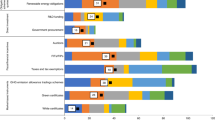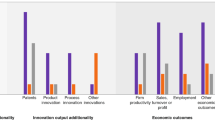Abstract
Data centre services hold promise for reducing societal carbon emissions, but an imperfect and evolving portfolio of performance metrics obscures which data centre characteristics correspond to low-carbon operations. Meanwhile, policymakers face a pressing question: can we identify and promote tangible characteristics that reliably represent low-carbon data centres today while the world awaits better metrics? Fortunately, data centre energy models can provide actionable guidance. Here, we present results that identify such characteristics and illuminate the factors that govern a data centre's actual carbon performance. These results can help public and private sector policymakers accelerate the transition to a low-carbon Internet by aligning data centre incentives with factors that truly matter.
This is a preview of subscription content, access via your institution
Access options
Subscribe to this journal
Receive 12 print issues and online access
$209.00 per year
only $17.42 per issue
Buy this article
- Purchase on Springer Link
- Instant access to full article PDF
Prices may be subject to local taxes which are calculated during checkout


Similar content being viewed by others
References
Hilbert, M. & López, P. The world's technological capacity to store, communicate, and compute information. Science 332, 60–65 (2011).
The Climate Group SMART 2020: Enabling the Low Carbon Economy in the Information Age (Creative Commons, 2008); available at http://www.smart2020.org/_assets/files/02_Smart2020Report.pdf
Koomey, J. Worldwide electricity used in data centers. Environ. Res. Lett. 3, 034008 (2008).
Koomey, J. G. Growth in Data Center Electricity Use 2005 to 2010 (Analytics Press, 2011); available at http://www.analyticspress.com/datacenters.html
Brown, R. et al. Report to Congress on Server and Data Center Energy Efficiency: Public Law 109–431. Report No. LBNL-363E (Lawrence Berkeley National Laboratory, 2007).
Masanet, E., Brown, R. E., Shehabi, A., Koomey, J. G. & Nordman, B. Estimating the energy use and efficiency potential of U.S. data centers. Proc. IEEE 99, 1440–1453 (2011).
Koomey, J. G., Brill, K. G. & Turner, W. P. A Simple Model for Determining True Total Cost of Ownership for Data Centers (Uptime Institute, 2007).
Glanz, J. Power, pollution, and the Internet. The New York Times A1 (23 September 2012).
Erdmann, L. & Hilty, L. Scenario analysis: Exploring the macroeconomic impacts of information and communication technologies on greenhouse gas emissions. J. Ind. Ecol. 14, 826–843 (2010).
Verdantix Cloud Computing –The IT Solution for the 21st Century (Carbon Disclosure Project, 2011).
Weber, C. L., Koomey, J. G. & Matthews, H. S. The energy and climate change implications of different music delivery methods. J. Ind. Ecol. 14, 754–769 (2010).
Salesforce.com in collaboration with WSP Environment & Energy Salesforce.com and the Environment: Reducing Carbon Emissions in the Cloud (WSP Environment & Energy, 2011); available at http://www.salesforce.com/assets/pdf/misc/WP_WSP_Salesforce_Environment.pdf
Accenture in collaboration with WSP Environment & Energy Cloud Computing and Sustainability: The Environmental Benefits of Moving to the Cloud (Accenture and WSP Environment & Energy, 2010); available at http://www.accenture.com/us-en/Pages/insight-environmental-benefits-moving-cloud.aspx
Google Google's Green Computing: Efficiency at Scale (Google, 2011); available at www.google.com/green/pdfs/google-green-computing.pdf
Koomey, J. G., Berard, S., Sanchez, M. & Wong, H. Implications of historical trends in the electrical efficiency of computing. Ann. Hist. Comput. 33, 46–54 (2011).
US Department of Energy Best Practices Guide for Energy-Efficient Data Center Design (Federal Energy Management Program, 2011); available at http://www1.eere.energy.gov/femp/pdfs/eedatacenterbestpractices.pdf
Samson, T. The green IT stars of 2010. InfoWorld (22 April 2010); available at http://www.infoworld.com/d/green-it/the-green-it-stars-2010-454
Lammers, H. At NREL, even the ones and zeros are green. NREL Newsroom (6 July 2011); available at http://www.nrel.gov/news/features/feature_detail.cfm/feature_id=1505
Smalley, G. 2011: The year data centers turned green. Wired (30 December 2011); available at http://www.wired.com/wiredenterprise/2011/12/green-data-centers-of-2011
Gelber, R. Facebook showcases green datacenter. HPCwire (26 April 2012); available at http://www.hpcwire.com/hpcwire/2012-04-26/facebook_showcases_green_datacenter.html
Google Our Energy-Saving Data Centers (Google, accessed 11 July 2012); available at http://www.google.com/about/datacenters/index.html
Laursen, L. Iceland exports energy as data. MIT Technology Review (11 April 2012); available at http://www.technologyreview.com/news/427468/iceland-exports-energy-as-data
Kessler, R. A. NextEra wind farm supplying power for Google data center. Recharge News (29 November 2011); available at http://www.rechargenews.com/energy/wind/article291445.ece
SustainableBusiness.com Two large California concentrating solar projects get $2B loan guarantee. SustainableBusiness.com (16 June 2011); available at http://www.sustainablebusiness.com/index.cfm/go/news.display/id/22553
Sayer, P. New eBay data center will run on fuel cells. PC World (21 June 2012); available at http://www.pcworld.com/businesscenter/article/258098/new_ebay_data_center_will_run_on_fuel_cells.html
LaMonica, M. Apple data center helps fuel Bloom Energy move to east coast. CNET (30 April 2012); available at http://news.cnet.com/8301-11386_3-57424037-76/apple-data-center-helps-fuel-bloom-energy-move-to-east-coast
BCS Future of Data Centre Efficiency Metrics: A Review of Progress so Far and a Suggested Direction for Further Development (BCS, 2010).
The Green Grid Harmonizing Global Metrics for Data Center Energy Efficiency (The Green Grid, 2011).; available at http://www.thegreengrid.org/en/Global/Content/Reports/HarmonizingGlobalMetricsForDataCenterEnergyEfficiency
Wang, L. & Khan, S. U. Review of performance metrics for green data centers: a taxonomy study. J. Supercomput. 63, 639–656 (2011).
Belady, C., Azevedo, D., Patterson, M., Pouchet, J. & Tipley, R. Carbon Usage Effectiveness (CUE): A Green Grid Data Center Sustainability Metric. White Paper No. 32 (Green Grid, 2010).
Stanley, J. R., Brill, K. G. & Koomey, J. G. Four Metrics Define Data Center “Greenness” (Uptime Institute, 2007).
Haas, J. et al. Proxy Proposals for Measuring Data Center Productivity. White Paper No. 17 (Green Grid, 2009).
Cook, G. & Van Horn, J. How Dirty is your Data? A Look at the Energy Choices that Power Cloud Computing (Greenpeace International, 2011); available at http://www.greenpeace.org/international/Global/international/publications/climate/2011/Cool%20IT/dirty-data-report-greenpeace.pdf
Emerson Network Power Recycling Ratios: The Next Step for Data Center Sustainability (Emerson Electric, 2011); available at http://www.emersonnetworkpower.com/en-US/Documents/EDC/Market%20Position%20Paper%20-%20Recycling%20Ratios_6.pdf
Bash, C. et al. Cloud Sustainability Dashboard, Dynamically Assessing Sustainability of Data Centers and Clouds Report No. HPL-2011-148 (HP Labs, 2011); available at http://www.hpl.hp.com/techreports/2011/HPL-2011-148.pdf
Mahadeven, P., Shah, A. & Bash, C. Reducing lifecycle energy use of network switches. Proc. 2010 IEEE Int. Symp. Sust. Syst. Tech. (Washington DC, May 2010).
Fraunhofer, I. Z. M. & Europe, P. E. Ecodesign of EuP Products: Preparatory Studies LOT 5: Consumer Electronics: TV (European Commission, 2007); available at http://ec.europa.eu/energy/efficiency/studies/ecodesign_en.htm
Williams E., Ayres, R. U. & Heller, M. The 1.7 kilogram microchip: Energy and material use in the production of semiconductor devices. Environ. Sci. Technol. 36, 504–5510 (2002).
Williams, E. et al. Environmental, social, and economic implications of global reuse and recycling of personal computers. Environ. Sci. Technol. 42, 6446–6454 (2009).
Masanet, E. & Horvath, A. Enterprise strategies for reducing the environmental impacts of personal computers. Proc. 2006 IEEE Int. Symp. Electron. Environ. (San Francisco, California, IEEE 2006).
Belady, C., Rawson, A., Pfleuger, J. & Cader, T. Green Grid Data Center Power Efficiency Metrics: PUE and DCIE. White Paper No. 6 (Green Grid, 2008).
United States Environmental Protection Agency ENERGY STAR Data Center Energy Efficiency Initiatives (United States Environmental Protection Agency, 2012); available at http://www.energystar.gov/index.cfm?c=prod_development.server_efficiency
Shehabi, A. et al. Data center design and location: Consequences for electricity use and greenhouse-gas emissions. Build. Environ. 46, 990–998 (2011).
Eubank, H., Swisher, J., Burns, C., Seal, J. & Emerson, B. Design Recommendations for High-Performance Data Centers: Report of the Integrated Design Charrette (conducted 2–4 February 2003). (Rocky Mountain Institute, 2004).
Lovins, A. B. Energy End-Use Efficiency (Rocky Mountain Institute, 2005); available at http://www.rmi.org/images/other/Energy/E05-16_EnergyEndUseEff.pdf
Stanley, J. & Koomey, J. The Science of Measurement: Improving Data Center Performance with Continuous Monitoring and Measurement of Site Infrastructure (Analytics Press, 2009); available at http://www.analyticspress.com/scienceofmeasurement.html
Prakash, S., Liu, R., Schischke, K. & Stobbe, L. Timely Replacement of a Notebook under Consideration of Environmental Aspects (German Federal Environment Agency, 2012); available at http://www.oeko.de/oekodoc/1584/2012-440-en.pdf
Acknowledgements
Lawrence Berkeley National Laboratory is supported by the US Department of Energy under contract number DE-AC02-05CH11231.
Author information
Authors and Affiliations
Corresponding author
Ethics declarations
Competing interests
The authors declare no competing financial interests.
Supplementary information
Supplementary Information
S1: Methods, data sources, and assumptions for Figure 1 (PDF 508 kb)
Rights and permissions
About this article
Cite this article
Masanet, E., Shehabi, A. & Koomey, J. Characteristics of low-carbon data centres. Nature Clim Change 3, 627–630 (2013). https://doi.org/10.1038/nclimate1786
Received:
Accepted:
Published:
Issue Date:
DOI: https://doi.org/10.1038/nclimate1786
This article is cited by
-
Aligning artificial intelligence with climate change mitigation
Nature Climate Change (2022)
-
Assessing the suitability of the Greenhouse Gas Protocol for calculation of emissions from public cloud computing workloads
Journal of Cloud Computing (2020)
-
Comparing datasets of volume servers to illuminate their energy use in data centers
Energy Efficiency (2020)
-
Power Efficient Clustering Scheme for 5G Mobile Edge Computing Environment
Mobile Networks and Applications (2019)



